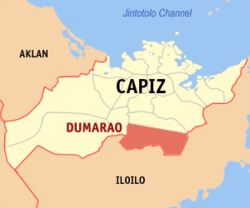Dumarao, Capiz
| Dumarao | |
|---|---|
| Municipality | |
 Map of Capiz with Dumarao highlighted | |
.svg.png) Dumarao Location within the Philippines | |
| Coordinates: 11°16′N 122°41′E / 11.267°N 122.683°ECoordinates: 11°16′N 122°41′E / 11.267°N 122.683°E | |
| Country | Philippines |
| Region | Western Visayas (Region VI) |
| Province | Capiz |
| Legislative district | 2nd district of Capiz |
| Barangays | 33 |
| Government[1] | |
| • Mayor | Leslie Warren A. Benjamin |
| Area[2] | |
| • Total | 232.56 km2 (89.79 sq mi) |
| Population (2010)[3] | |
| • Total | 43,986 |
| • Density | 190/km2 (490/sq mi) |
| Time zone | PST (UTC+8) |
| ZIP code | 5812 |
| Dialing code | 36 |
Dumarao is a second class municipality in the province of Capiz, Philippines. According to the 2010 census, it has a population of 43,986 people.[3] It was founded in 1580 and established by Spaniards under the advocacy of Our Lady of Snows.
Barangays
Dumarao is politically subdivided into 33 barangays.[2]
- Agbatuan
- Aglalana
- Aglanot
- Agsirab
- Alipasiawan
- Astorga
- Bayog
- Bungsuan
- Calapawan
- Codingle
- Cubi
- Dacuton
- Dangula
- Gibato
- Guinotos
- Jambad
- Janguslob
- Lawaan
- Malonoy
- Nagsulang
- Ongol Ilawod
- Ongol Ilaya
- Poblacion Ilawod
- Poblacion Ilaya
- Sagrada Familia
- Salcedo
- San Juan
- Sibariwan
- Tamulalod
- Taslan
- Tina
- Tinaytayan
- Traciano / Agsalay
Demographics
| Population census of Dumarao | ||
|---|---|---|
| Year | Pop. | ±% p.a. |
| 1990 | 36,801 | — |
| 1995 | 38,037 | +0.62% |
| 2000 | 40,303 | +1.25% |
| 2007 | 42,603 | +0.77% |
| 2010 | 43,986 | +1.17% |
| Source: National Statistics Office[3][4] | ||
References
- ↑ "Municipalities". Quezon City, Philippines: Department of the Interior and Local Government. Retrieved 15 February 2013.
- 1 2 "Province: Capiz". PSGC Interactive. Makati City, Philippines: National Statistical Coordination Board. Retrieved 15 February 2013.
- 1 2 3 "Total Population by Province, City, Municipality and Barangay: as of May 1, 2010" (PDF). 2010 Census of Population and Housing. National Statistics Office. Retrieved 15 February 2013.
- ↑ "Province of Capiz". Municipality Population Data. LWUA Research Division. Retrieved 16 August 2013.
External links
 |
Dumalag | Cuartero |  | |
| |
Lemery, Iloilo | |||
| ||||
| | ||||
| Bingawan, Iloilo | Passi, Iloilo | San Rafael, Iloilo |
This article is issued from Wikipedia - version of the 9/1/2016. The text is available under the Creative Commons Attribution/Share Alike but additional terms may apply for the media files.